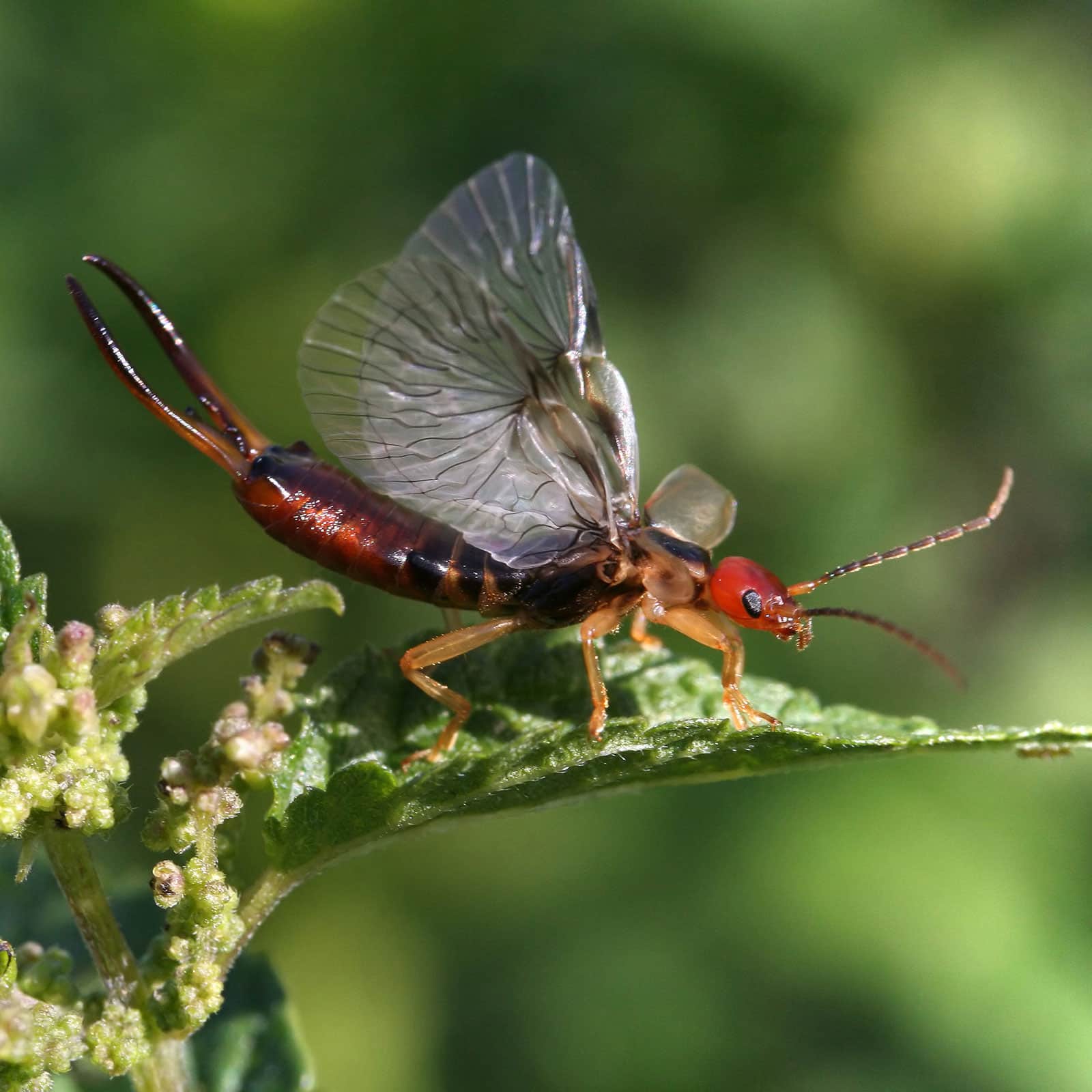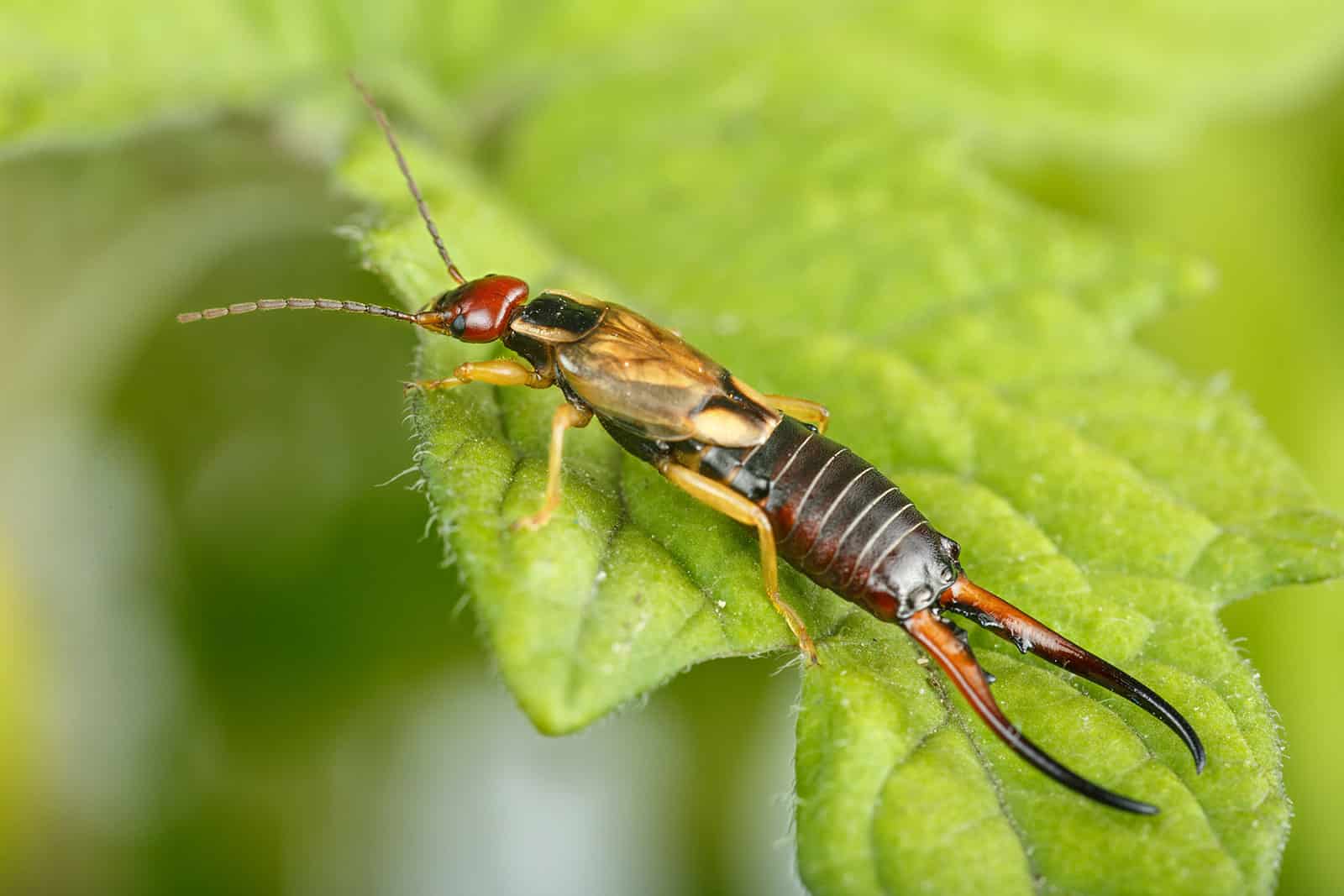“Why are there so many holes in my leaves?” is the question I’m often asked in summer.
And the answer to that, for most people, is earwig damage.
These nasty little pests can decimate entire seedlings in short time and make your plants quite unsightly and unpalatable, but it’s not entirely fair to call them pests because they are—to some extent—beneficial in the garden as well.
Earwigs are great decomposers, feeding on dead or dying plant material, rotting wood, and other organic matter. They also feed on other garden pests like aphids and scale insects, helping your yard maintain balance in the ecosystem.
But at what cost to your garden? Because at some point, when their population becomes large enough and they run out of things to eat, they’ll start to eat your living plants and that’s where they turn troublesome.
Disclosure: If you shop from my article or make a purchase through one of my links, I may receive commissions on some of the products I recommend.

What are earwigs?
First, what’s up with the name?
“Earwig” comes from the Old English ēare (meaning ear) and wicga (meaning beetle). Entomologists believe the origins of the name refer to the insect’s hindwings, which resemble a human ear when unfolded.
Yes—most earwigs have wings! The way they fan out and fold up their wings is actually quite amazing, like nature’s origami.
While this means they can technically fly, earwigs rarely do, preferring to hitch a ride on luggage, newspapers, bouquets of flowers, or crates of produce.
Perhaps a more popular theory of where the term “earwig” came from is the old wives’ tale that earwigs crawl into your ears at night, burrow into your brain and lay eggs in there while you’re sleeping.
If that doesn’t give you nightmares, just the sight of earwigs alone is kind of frightening.
Common earwigs (like the European earwig and ring-legged earwig) are about 16 mm long with dark, flat, glossy bodies; six legs; two antennae; and a set of menacing-looking, forcep-like pincers (known as cerci) that extend from their abdomens, giving them the nickname “pincher bugs.”
It’s easy to tell male and female earwigs apart by the shape of their cerci. A male’s cerci is curved, while a female has a straight pair of cerci.

In spite of their appearance, earwigs don’t seek out human ears (or brains). I can’t say that they never find their way into people’s ear canals though, just that they’re unlikely to, since they’re more interested in your food and garbage.
Nor do they go around pinching humans—and even if they did, you’re not likely to feel it anyway. Earwigs have no venom and their pinch is pretty weak, making them harmless to humans.
There are 22 identified species of earwigs in the United States, but only a handful are commonly seen and the most prevalent one in our homes and gardens—the European earwig (Forficula auricularia)—is actually non-native.
Adult European earwigs mate in late summer and early fall before establishing nests underground. Most earwigs produce one generation per year, though a female can sometimes produce two broods.
In the first batch, a female earwig lays between 30 to 55 eggs, which hatch in about 70 days. The second batch typically has fewer eggs and hatches in about 20 days, thanks to warmer summer temperatures. So, you can see how quickly earwigs are able to multiply in a single season!

While they’re a nuisance for sure, earwigs don’t usually cause widespread damage to a garden. The nocturnal insects like to hide during the day in dark, damp, tight spaces and then come out at night to hunt and eat.
They’re scavengers, seeking out decaying organic matter, grass, lichen, moss, flowers, soft fruits, shrubs, vegetable crops, and other plants, as well as other arthropods (living or dead) and even insect eggs.
If your yard is consistently cool and moist and thick with plants or garden debris, you’re likely to encounter earwigs.
So what can you do about them?
My MO is this: If the damage is minimal, I tend to leave them alone. If there are far more earwigs hanging around than I’d like, then I take the following steps to make my yard a much less desirable place for them to feed and breed.

How to keep earwigs out of your garden
As with most methods of pest control, prevention is key. The best way to keep earwigs out of your garden is to make it as inhospitable as possible to these opportunistic pests.
1. Don’t overwater your garden.
The one year my own garden was overrun with earwigs, we were having an intense, multi-week heat wave early in the summer, and I was wetting down my garden beds twice a day to keep my leafy crops cool.
Related: 7 Hot-Weather Watering Tips to Survive a Heat Wave
The combination of excess water, thick leaf and straw mulch, dense vegetation, and forty-degree temperature swings between day and night meant the garden never fully dried out, making it a haven for earwigs that love damp environments.
Learn from my mistake: If you’re hand watering your plants, time it so that the soil has a chance to dry out a bit before nightfall.
Remember to adjust irrigation schedules throughout the season and turn off drip irrigation during periods of rainy weather (or, invest in weather-based irrigation controllers that’ll do all this work for you).
Recommended weather-based irrigation controllers:
- Rachio 3 Smart Sprinkler Controller
- Orbit B-hyve Smart Sprinkler Controller
- Rain Bird App-Based Smart Irrigation WiFi Timer/Controller
2. Fix leaky pipes and plumbing fixtures.
Check your yard for leaking spigots, pipes, hoses, and other fixtures that are dripping water, and clean out gutters and drain pipes where earwigs are likely to take shelter.
Earwigs prefer cool, moist areas, so you want to prevent any accumulation of excess moisture as much as possible.
3. Remove piles of dead leaves, rotting wood, and other yard debris near your garden.
Earwigs love to make their home in these types of organic materials, as well as other dark, damp, confined hiding places like compost piles and wood piles. Try to store all of these items as far from the garden as possible to limit the number of places earwigs can get into.
If there’s thick and heavy underbrush near your garden beds, try to clean them up so earwigs can’t hide in them during the day.
4. Use pot feet or elevated planters.
Ever lift up a pot in the garden and find earwigs and other bugs scattering as soon as the light hits them?
Just like those wood piles you need to keep away from the garden, you also want to reduce the chances of earwigs hiding under dark, moist pots and planters. I like putting pot feet under containers to get them off the ground an inch or two, or using elevated planters and pots to keep the ground dry underneath.
Favorite pot feet for containers:
- Invisible Pot Feet (Solid Rubber Risers)
- Pot Toes (Dark Gray or Terracotta)
- Pot Risers (For Large Pots)
- Teak Planter Feet
5. Plant things that earwigs don’t like in and around your other plants.
Like many pests, earwigs hate the strong smells of certain plants like rosemary, lavender, peppermint, garlic, and onions (including members of the onion family, such as chives).
Don’t count on these plants to solve all your earwig woes, however. Personally, I would use this tip in combination with the next solution to not only repel earwigs, but attract their enemies for a double whammy.
6. Grow plants that attract earwigs’ natural predators.
Tachinid flies are predatory insects that you definitely want to keep around in your yard, as they make an excellent biological control for pests. They’re a parasitic species of flies whose larvae feed inside host insects, including earwigs.
Tachinid fly larvae can consume an incredible amount of pests this way, so it’s worth growing a wide variety of nectar-rich plants to attract adult tachinid flies and encourage them to stay and lay eggs.
They especially love umbel-shaped flowers, such as those found on Queen Anne’s lace, carrots, dill, fennel, and cilantro, as well as anise hyssop, sweet clover, sweet alyssum, and buckwheat.
These are the same flowers that attract bees to your garden, as well as predatory wasps (like yellow jackets) that prey on earwigs when they’re abundant.
Read next: 3 Easy Recipes for Attracting Beneficial Insects to Your Garden

How to get rid of earwigs
What if you already have an established population of earwigs in your garden?
Don’t panic! If you’re dealing with an infestation, there are some good old-fashioned (and relatively non-toxic) ways to get rid of them for good.
If you see—or suspect—earwigs in your garden, here’s what you can do about them.
1. Make a DIY earwig trap.
I’ve tried many methods for controlling earwigs, and this simple homemade trap is the best I’ve found for killing hundreds of earwigs in short time. All it takes is a couple of household pantry ingredients, making it safe to use around pets and children.
Step 1: Fill a small container (like an empty tub of sour cream, a tuna can, or a carton of milk cut in half) about halfway with 2 parts cooking oil and 1 part soy sauce.
Step 2: Bury the container in the soil (up to the rim) near where you see lots of earwig damage on your plants and leave it overnight.
Step 3: The next morning, prepare to see dozens of dead earwigs in your oily trap! Leave the trap for a couple of days, then dump it in the trash and start again with fresh oil and soy sauce.
2. Use food-grade diatomaceous earth.
Food-grade diatomaceous earth (the DE found in garden centers, not the DE that’s sold as a swimming pool additive) is a safe and effective way to control a number of pests, including earwigs.
Diatomaceous earth is a naturally occurring, mined substance that looks like ash. It’s made from the fossilized shells of diatoms (a type of microalgae). These microscopic particles—largely composed of silica—will dehydrate and shred the exoskeletons of soft-bodied bugs that come in contact with them.
Simply sprinkle diatomaceous earth around the base of your plants on dry soil and/or use a duster (like this one) to apply puffs of DE onto the leaves or onto earwigs directly.
DE does lose its effectiveness when wet, so try to time your application long after your plants have been watered. After rain or irrigation washes it away, DE will once again need to be applied to continue to work.
A caveat: While diatomaceous earth works very well for getting rid of earwigs and other pests like aphids and mites, it may also harm garden friends like spiders and beetles. So be strategic in how and where you use it.
DE is also quite dusty and for sensitive people, it’s best to wear a mask because this is not the kind of stuff you want to be breathing into your lungs.
Recommended diatomaceous earth for earwig control:
- Harris Food-Grade Diatomaceous Earth
- Harris Food-Grade Diatomaceous Earth with Easy Application Puffer Tip
- Safer Brand OMRI-Listed Diatomaceous Earth
3. Use neem oil.
Neem oil is a vegetable oil made from the fruits and seeds of neem trees, which are native to India.
It’s a popular natural 3-in-1 pesticide for managing insects that feed on plants (like earwigs and leaf miners), as well as controlling fungal and bacterial issues (like rust, powdery mildew, leaf spot, and fire blight).
Neem controls pests in one of two ways. First, it coats leaves in an oily layer that suffocates pests that try to feed on plants.
Second, the active ingredient in neem, azadirachtin, works by disrupting the hormones that control an insect’s growth and reproduction processes, thereby reducing pest populations.
It’s most effective on immature pests and less likely to kill mature pests, which might continue to feed and reproduce. So, neem oil does require multiple applications, and yields the best results when timed with earwig life cycles.
You can find neem oil in ready-to-use spray bottles and the formula works on all types of plants, including vegetables, fruits, nuts, and ornamental flowers.
Recommended neem oil formulas for earwig control:
- Bonide Captain Jack’s Neem Oil Ready-to-Use Spray
- Natria Neem Oil Ready-to-Use Spray
- Harris Neem Oil Concentrate
















Please add a caution when you recommend neem oil … it is deadly to bees and can disrupt and entire hive.
love reading all your well researched information.
I have used old cut up garden hose to trap the ear wigs. I cut about 12″ and place them around the gardens. In the morning the ear wigs go in to get out of the light. I’ll get them before the sun hits the hose and gets to hot for them. They will leave. I take the hose can knock it against my bucket that has dishwash soap in it. They won’t survive in the soapie water. You’ll be surprised how many you get.
Earwigs are usually a major problem here (foothills, central CA foothills), and as mentioned, especially if it’s a large population year. We make a trap also, but slightly different. Because we have to water overhead only (long story), we can’t have an open container. So we use small plant-based “cream cheese” type containers, preferably about 2″ deep, with a SOLID lid that snaps on securely.
Around the container, we poke four holes about 3/8″ diameter each–big enough for an earwig to crawl into the container. A slightly heated ice pick works well. The holes are placed about 1/2″ below the lid because we bury part of the container.
For the trap “bait,” we mix 1 part soy sauce; 1.5 to 2 parts water; and just enough salad oil to have a slight film floating on top (1/16” to 1/8″ thick or so works fine). The top of the oil should be about 1/2″ below the holes.
We take it to the garden (carry carefully not to spill, OR wait and put the bait in at the site). We make a slight indention in the soil to bury the container maybe 3/4″ deep or so (make sure the holes are above the soil line). In a few days, after earwigs find it, they’re done—lots of them.
Sometimes, another mammal may raid the garden beds to get the bait (!). Other than our dog, we haven’t figured out who would want that bait.
IF that happens, the container should be found fairly nearby and be reused (dog’s mouth may smell like soy sauce if caught early enough….). We don’t blame him; we just make the bait less accessible.
We then put protection OVER the trap as well (like larger plastic containers that may have held a pound or more of mushrooms) with small openings cut out for earwigs to get to. We weight that down (rocks, ties, whatever). It should work, but once, we had a very determined mammal—not our dog that time! We staked hardware cloth around all of it (earwigs could get through), tied it down, and it worked.
This “trap” may work best if started VERY early in the Spring—before they lay all those eggs.
I’ve caught opossums with mine (I’m in the Mt. Diablo foothills). It does seem to attract the possums less if I leave out the soy sauce, but since they eat earwigs anyway I’ve had mixed feelings about discouraging them totally.
I love your idea! I have a similar one, but for some reason, I never thought to put the holes in the side, which sounds like a much better idea. I use empty yogurt tubs, but I’ve been putting the holes in the lid. I’m going to try putting them in the side with a rock on top. Hopefully, I can keep the opossums and the traps without a big mess in the yard
I did have an earwig climb into my ear. I woke up in the middle of the night, feeling this creepy crawler already in my ear. I ran into the bathroom, bent my head sideways over the sink, and started hitting the outside of my ear. The more I hit, the further inside my ear he crawled. I was so freaked out, I didn’t know what to do. I tried a cotton applicator, I tried pouring water into my ear, and eventually, after what seemed like hours, the earwig fell into the sink. I went to see my doctor the next day and he said the inside of my ear was “scratched” and gave me an antibiotic. This happened over a year ago, and I definitely have PTSD, so every night during the summer months, I put cotton in my ears. I call this my worst nightmare!